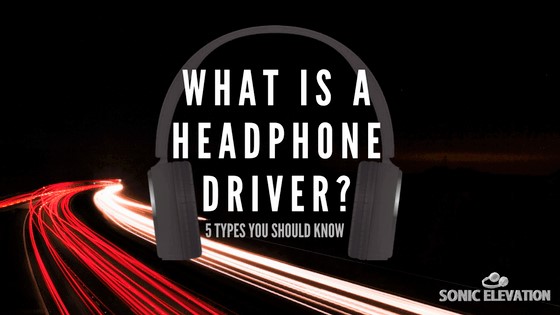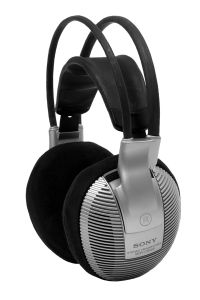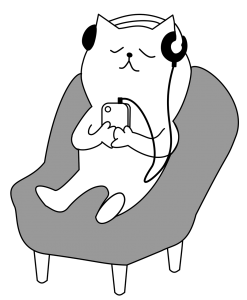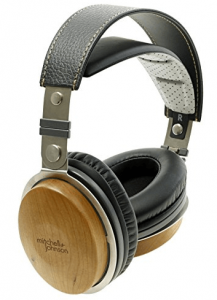
What Is A Headphone Driver? 5 Types You Should Know
You’re curious about the inner-workings of headphones, right? Some say “curiosity killed the cat”, but healthy curiosity serves as the fuel for learning. Learning about what, why, and how your headphones work is a great way to gain useful knowledge that’ll help you further down the road.
“What Is A Headphone Driver?”, you ask. We’ll explore that question and take a closer look at why it matters. A pair of headphones without its drivers would be like a car without a driver. They would just sit there collecting dust. The car wouldn’t move an inch – and the headphones wouldn’t be able to make a sound. (Some models might look pretty cool as paperweights, but we want to hear the music, right?)
Are you ready to learn about this extremely important headphone component, how it works, and why it’s necessary? Let’s dive into the sea of information and see how they affect and produce the audio waves we all love and enjoy!
What Is A Headphone Driver
A headphone is made up of several components. Each internal piece that lives inside your earbuds or the ear cups of your ‘phones works like clockwork to produce audio. The driver’s main purpose is to convert an electrical signal into the sound of your music.
Like the car analogy we used above – without the driver, there would be no sound. You’ve probably seen something like this:
- “40 mm and/or 50 mm drivers” next to the headphone specifications that you have your eye on
The “mm” (millimeters) represents the size of the driver that’s in each ear cup. In this case, size does matter. The size and type of driver will play a significant role in producing different levels of sound quality. Let’s take a look at the different types and how they affect your sonics.
What Are The Different Types Of Drivers?
- Dynamic (aka Moving Coil)
- Planar Magnetic
- Balanced Armature
- Electrostatic
- Magnetostriction (aka Bone Conduction)
Now, we’ll go over how each driver type operates, what kinds of headphones most commonly use each type and the pros/cons of each.
1. Dynamic (aka Moving Coil) – Most Commonly Used

Dynamic drivers are made of 3 main components: a neodymium magnet, voice coil, and a diaphragm (attached to the voice coil). The lightweight neodymium magnet activates the voice coil – which then causes the diaphragm to vibrate. This vibration creates the sound waves that manifest as your favorite song or album.
Let’s take a look at the pros and cons of dynamic drivers:
Pros:
- Doesn’t require very much power output for louder volume
- Less-expensive to make, therefore more budget-friendly
- Creates a powerful bass response
Cons:
- Tends to give out faster (especially in cheap headphones)
- Can distort your audio at higher volumes
2. Planar Magnetic – Usually Found In High-End Headphones
Planar magnetic drivers create sound using a similar mechanism to dynamic drivers. Instead of activating the voice coil – both magnets (2 in each ear cup) absorb the electric signal and cause the diaphragm (in between both magnets) to vibrate. Since the electrical signal is absorbed by a larger surface (rather than a single voice coil) it creates a louder, fuller sound.
This type of driver is pretty uncommon in the mainstream headphone world. You’ll find planar magnetic drivers in high-end, expensive cans that can cost well over $2,000 in some cases. One reason for their extra high price tag is because it takes more materials to make a pair. That’s due to the housing of 2 magnets (instead of 1), and the extra outside materials that encase the driver units.
Let’s take a look at the pros and cons of planar magnetic drivers:
Pros:
- Extremely high fidelity audio reproduction
- Low distortion at higher volumes
- Full, powerful bass response
Cons:
- Usually more expensive
- Build design is bulkier (to fit both magnets in each ear cup)
3. Balanced Armature – Commonly Seen In Earbuds/IEMs

Since balanced armature drivers are smaller in size, they tend to be most common in IEMs and earbuds. They are also more expensive than ‘phones with dynamic drivers. Here’s why:
- Each ear features a mini arm (armature) inside the voice coil
- The mini arm and voice coil have magnets on either side (2 total)
- A “drive rod” (attached to the armature) moves back and forth to push the air/audio waves out, into your ear
- Sometimes each ear has both dynamic and balanced armature driver types
Here’s a brief rundown of their function. An electrical signal is sent to the voice coil, the armature becomes magnetized and both magnets (surrounding the voice coil) create a powerful magnetic field, creating audio waves. The drive rod (attached to the armature) then moves back and forth and pushes the audio waves out and into your ears.
This complex process leads to the creation of a balanced, accurate wave of sound that makes your music sound even better. If that seems a little confusing, here’s a short video explaining the full process with some easy-to-follow visuals:
Sometimes, IEMs will have both a dynamic and balanced armature driver in each ear (which is another reason why they’re more expensive – and why they produce hi-res sound quality).
Basically, the extra magnets/components and occasional dynamic/armature combination + the ultra-compact size make them a top choice for musicians, audiophiles, and audio professionals.
Let’s take a look at the pros and cons of balanced armature drivers:
Pros:
- Well-balanced sound profile
- Ultra-compact build (making them perfect for on-the-go/portable listening)
- Provides passive noise isolation (due to the in-ear canal fit)
Cons:
- More expensive (especially custom-molded IEMs)
- Can be hard to find a pair of in-ear/earbuds that fit your ears perfectly
4. Electrostatic – Commonly Seen In High-End Open Back ‘Phones
Electrostatic drivers utilize static electricity to produce high-quality audio. Instead of using magnets to cause vibration (and the resulting sound) – two opposing electrical currents vibrate a thin membrane.
This results in more accurate sound reproduction. They usually perform better in the upper range of frequencies. Your highs and mids will be crisper, but the bass won’t be as powerful.
Electrostatic drivers aren’t very common, although you can find them in higher-end open back headphones. That’s also part of the reason that open-back headphones produce some of the best “true-to-live” sounds. (You’re starting to see how specific driver types play an important role in the type of audio playback, right?)
Let’s take a look at the pros and cons of electrostatic drivers:
Pros:
- Pristine highs and mids
- “True-to-life” audio playback (if you love the live concert experience)
- Accurate sound, but subdued volume
Cons:
- No heavy, powerful bass response
- More expensive and hard to find
5. Magnetostriction (aka Bone Conduction) – “Bonephones”
Magnetostriction drivers (aka Bone Conduction) drivers act on a mechanism that bypasses your eardrum. The concept was invented by Beethoven (since he was practically deaf) when he attached a rod to his piano, stuck the rod in his mouth – and was able to hear his piano playing. (Pretty ingenious right?)
Bonephones (they’re not as morbid as they might sound, no pun intended) sit in front of your ears, rather than inside your ears. The sound is created by sending electrical currents into the headphones. Then, the audio waves vibrate a bone in your skull called the cochlea.

The cochlea looks similar to a snail shell. When audio waves cause it to vibrate – it sends a signal to the stereocilia. The stereocilia (inner ear hair cells) start to move and sends those bone vibrations to the brain, so it can process the signals and you can hear your music. (Have you ever wondered where the term “stereo” came from? *Hint hint, wink wink, nod nod).
Let’s take a look at the pros and cons of magnetostriction (aka bone conduction) drivers:
Pros:
- Ability to hear ambient noise (passing cars, etc.)
- Especially helpful for those with partial hearing loss
- Great for roadside biking, running, or working out
Cons:
- Sound won’t be as full or powerful
- Semi-limited practical use (for most)
Rest Easy, Now You Know What Each Driver Type Means!
Now that you’ve read through this guide, you can answer your original question of “What Is A Headphone Driver?“. The days of stressing out over driver types are over. You know what each of the 5 different types is, what kind of headphone they’re most commonly found in, and the distinctions between them.

The analogy that we kicked it off with should make a lot more sense now. Just like a car without a driver behind the wheel, your headphones need something to literally drive the waves of audio into your ears.
The next time you’re ready to look for a new pair of headphones, you can navigate the complicated spec sheets like a true expert. You know everything you need to about this aspect of ‘phones. To see more helpful information that you’ll want to know before buying a new pair, take a look at our Headphone Buying Guide.
I hope you found this information helpful and enjoyed reading it! What kind of headphone do you think you’ll try next? Which type sounds the most appealing? If you have a question, feel free to ask below. I’ll do my best to respond as quickly as I can. Thanks for stopping by!
Sonic Elevation: Ride The Waves.
- Korg B2 vs Roland FP10 | Which One To Buy - May 13, 2021
- How Does Music Affect The Brain? – Let’s Find Out! - April 6, 2021
- Why Are My Headphones Crackling? – How To Fix It - April 3, 2021




Hi Dom,
Great article on headphone drivers. As an electrical engineer who has a lot of experience with audio engineering and music, I really liked the way you described the different types. Do you have a background in electronics, music or both? I am just curious since I can tell you are very knowledgeable.
Thanks Tony, those are flattering words coming from someone with your background. 🙂
I tried to explain the different types of headphone drivers in a way that’s easy to understand regardless of how much previous knowledge a reader has.
I did start learning how to play the piano and trumpet from an early age which eventually progressed into writing and recording music (as a hobby). After spending countless hours writing, recording, playing, researching, and reading – I’ve been able to acquire some real life experience and knowledge in this area.
I’ve been able to learn a lot from other more-experienced people that have helped along the way. Feel free to read more here if you’re interested in learning a little bit more about my background.
I appreciate you stopping by and once again, thanks for the kind words – I’m glad you enjoyed reading this post!
Actually, I have always known that the idea behind listening to sounds is to have digital signals convert into analog sounds for our ears to receive. I just didn’t know that is known as the headphone driver. I also thought there was only one kind of headphone driver without realizing that there’s at least five types.
I have looked at all the headphone drivers you mentioned and seriously the bone conduction seems to be the coolest. It doesn’t send sounds directly into your ears, but it relies on bone conduction instead. I know it won’t be very loud because you are not using your ears, but it also means that other people can’t eavesdrop on it right?
The reason I think that is because the sound is transmitted through your bones and ossicles. Am I wrong?
You must be pretty well studied on headphones to already know that. 🙂 Headphone drivers are definitely a key component for personal listening.
Bone conduction headphones (aka Bone Phones) don’t send the signals directly into your ear, no, they send the signal to a maze of smaller bones (the ossicle bones).
Once the audio waves pass through the ossicles, then your cochlea is activated and sends the signal to your brain. You got it – as far as being “eavesdropped” on, other people around you won’t be able to hear what you’re listening to.
They do let outside noise in, but the way that they work doesn’t allow for much sound leakage, if any at all. Thanks for stopping by and asking some great questions! Hope to see you here again. 🙂